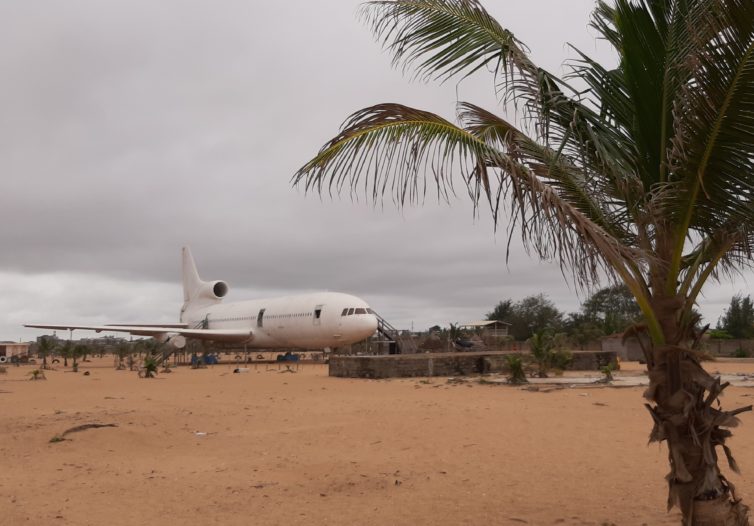
What a view! Could you imagine just seeing an L1011 on the beach? – Photo: Jerome de Vries
I was recently in Cotonou for a 24-hour layover. Cotonou is the largest city of the small west African nation of Benin, and has become a secondary hub for emerging airline RwandAir. Taking advantage of its growing network, I booked a RwandAir ticket from Dakar, Senegal to Kigali, Rwanda via Cotonou. The transit stop included accommodation provided by the airline.
What is there to do in Cotonou? A quick Google search indicated that the closest attraction to the hotel was on the beach: an ’˜amusement park’ called Air de Jeux Plage Ervan. This ‘park’ appeared to include a large-looking aircraft, so I decided to check it out. Little did I know the airframe was a historic Lockheed L1011 TriStar, full of amazing clues about its long and varied history around the world.

Mystery plane? – Image: Google Maps

Artist Impression of Future Airport – Image: Lockheed-California Company
I have always been a fan of all things esoteric, the unique, and perhaps even the underdog. Engineering oddities fascinated me from a young age; if it was different or somewhat outlandish, I was hooked. For that reason, it’s probably no surprise to many people that the aircraft I adore more than all others (yes, even more than Concorde) is the Lockheed L-1011 TriStar.
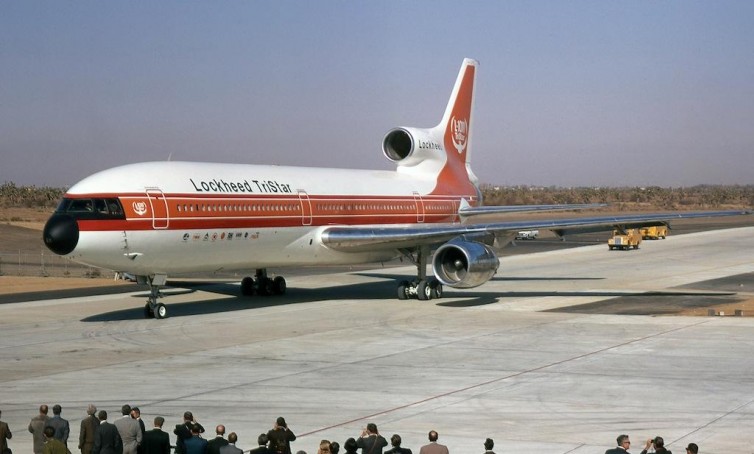
The L-1011 prototype after completing her first flight on November 16, 1970 – Photo: Jon Proctor
However, I can take things a step further, because for me, this is more than an aircraft; it represents the engineering prowess of hundreds of engineers ’“ one of whom I happened to know very well. A man who was lucky enough to spend a lifetime in aviation working for some of the most storied aeronautical firms in history, such as Avro Canada (later Hawker Siddeley), Convair, De Havilland Canada, and Lockheed. Prior to his death in 2013, this engineer described the L-1011 as his ’œmagnum opus’, his greatest achievement as an engineer and the work that he was most proud of.
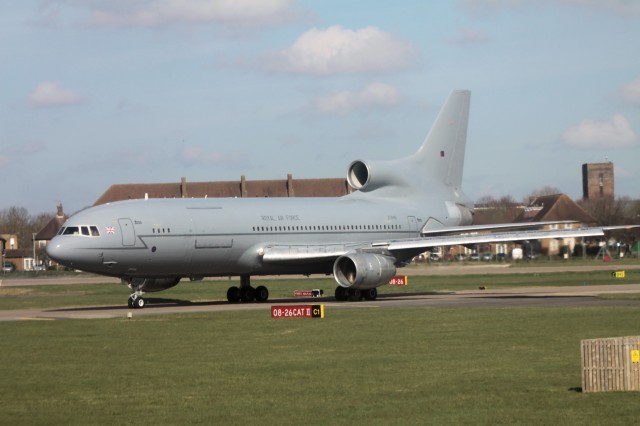
Lockheed L1011 Tristar, KC 1; ZD950; callsign ’œFAGIN 12’. Backtracking along the main runway, alongside ZD948 ’œFAGIN 11’ – Photo: Graham Dinsdale
This story was written by Graham Dinsdale, of Ian Allan Aviation Tours in England, for AirlineReporter…
04:00 GMT (Greenwich Mean Time); my bedside alarm clock shatters the silence and causes my wife to stir; at last, I thought, keen to get started on what promised to be an awesome – but very sad – day. I had dozed the night away, my brain too active to shut down and allow me to get any sleep. I had reasons for my lack of sleep – I was to fly on a Royal Air Force (RAF) Lockheed L1011 Tristar in formation!
After the usual morning routine I was out the door by 4:30 a.m., and starting my car for the two-and-a-half hour drive across the countryside of Cambridgeshire, Northamptonshire, and Oxfordshire to the RAF’s huge air transport base at RAF Brize Norton. I anticipated possible delays due to dense fog and mist covering most of the route, and the morning rush-hour road traffic around the university town of Oxford didn’t help, so I allowed plenty of time to get to the rendezvous point: an off-base car park a quarter of a mile from the station’s main gate.
For those not familiar with British nomenclature, the RAF have ’œstations’ not ’œair bases!’ The fog and road traffic was not as bad as the internet advised, so I arrive early, at 6:25. Time to open up the flask of coffee and munch a biscuit. Over the next 90 minutes more and more of the invited media, and some very lucky aviation enthusiasts, arrived.
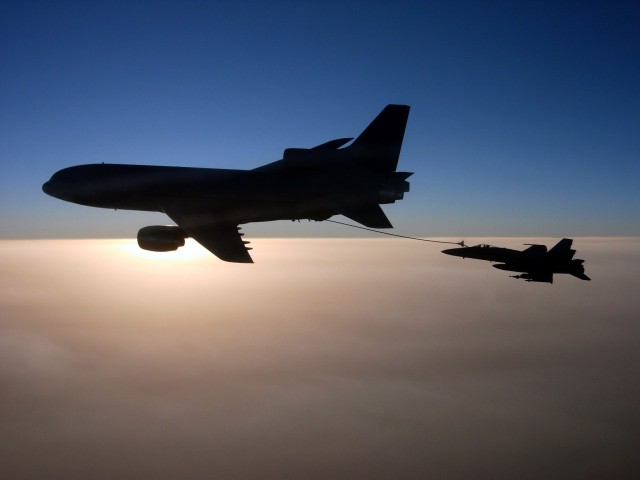
The twilight of the L1011 – refueling US Navy aircraft as part of Operation Enduring Freedom Photo: US Navy by Cmdr. Erik Etz
While 2014 may have been the end of commercial DC-10 services, many forget that the RAF (Royal Air Force) has been operating Lockheed L1011s (called “TriStars” in their parlance) as air-to-air refueling aircraft. Unfortunately for trijet enthusiasts, today marks the end of their service in the RAF. Even worse, they will be broken up in Bruntingthorpe.
As the resident Trijet Enthusiast – I was hoping for a little more notice from the RAF as to when the last RAF Tristar flight would happen. Thankfully, we have someone else who will be able to take the last flight and produce a fine report for AirlineReporter. As we await that final dispatch, let’s take a look back at the L1011 – an historical aircraft that even could have changed the pace of the Cold War.
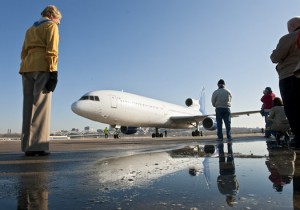
Jeanne Grauberger, who was a TWA flight attendant from 1956 to 1962, was among those at the Lockheed L-1011 touched down.
Most airline enthusiasts have a special place in their hearts for the Lockheed L1011 Tristar. There aren’t too many airborne around the world today. You might be able to catch the Sand’s L1011 that they flight high rollers to and from Las Vegas or you could have been in Kansas City, Missouri on Saturday. That is where one L1011, that started life at TWA, made its last flight to the Airline History Museum.
At first it looked like “Elle” (the name of the L1011) was heading to the scrap heap. A generous donation by Paul Pristo helped to not only save Elle from being destroyed, but also making her airworthy to do the flight from the desert in Roswell, New Mexico to the museum in Missouri.
Originally the flight was supposed to occur back in April, but the FAA put a stop to the flight due to serious safety concerns. To get approval from the FAA, Elle had to satisfy 28 airworthiness directives. The L1011 had a complex history, starting life in the US, but also flew in Africa and South America, where maintenance rules are more lax. There was also concern about the rear wing spar having cracks, which is a common issue for these large planes. Planes that were flying in the US had modifications done, but since Elle was out of country she did not. Luckily there were no signs of cracking and after $60,000 of mechanical upgrades, she was ready to make the journey.
On Saturday, Elle was ready to go and so were her fans. The flight crew has stayed certified on the L1011 by training on a surviving simulator owned by Delta Air Lines in Atlanta. Because of the age and potential issues, the FAA required only essential personal be on the plane, it wasn’t fully pressurized, and it must fly lower and slower than normal.
The flight on Saturday went perfect. It was exciting for the guest gathered to see this wonderful airplane fly once again. Elle will be turned into a classroom for children to come to the museum to learn about airlines and flight. It seems like she has found a wonderful new home.
Thank you @user47 for the tip!
Additional Information:
* More pictures from KansasCity.com
* Videos from Airline History Museum
* 37 photos of Elle’s history on Airliners.net
Image: John Sleezer via KansasCity.com






